The recent bull market that drove stock prices to record highs left IBM Corp. trailing the parade — an unusual position for the computer, software and consulting giant. Since its shares topped $214 in March 2013, just above its previous high set in October 2010, the Armonk, New York–based company has had to endure a numbing slide. Alone among the Dow Jones industrials, IBM posted a decline in its stock price last year. In early March 2014, shares changed hands at $185, just pennies above the January 1, 2014, price.
For some IBM fans hope springs eternal despite consecutive quarters of slumping sales and a fourth-quarter loss at the company’s hardware unit. Even Berkshire Hathaway chairman Warren Buffett recently felt compelled to assure CNBC viewers that IBM’s performance had not caused him to lose sleep over his $11.7 billion stake. And IBM’s board continues to forge ahead, voting in October to authorize an additional $15 billion to repurchase shares, over and above the $5.6 billion remaining from an earlier authorization. The expanded program represents more than twice the cash IBM devoted to R&D and engineering in 2012.
Buffett applauded the plan to shrink shares by nearly 8 percent. Alas, despite the investment sage’s endorsement, the fourth-quarter Institutional Investor Corporate Buyback Scorecard places IBM near the bottom of the ranking. Share buybacks at IBM over an eight-quarter period declined in value by 6.9 percent. In dollar terms IBM buybacks over that period surrendered $1.4 billion in market value. That may sound like a rounding error for a company with a market capitalization of nearly $200 billion, but it’s a reminder that ill-timed buybacks punish shareholder value.
| Buyback Scorecard The S&P 500 as Stock Repurchasers Best and Worst Programs Industry Comparisons |
The scorecard examines eight quarters of buybacks, enough time for most investments to produce satisfactory returns. Longer time frames make some buybacks appear better and others worse. Using a methodology similar to that of the Buyback Scorecard but going back to 2009, IBM calculates an annual gain of 9 percent for its share repurchases, against average annual gains by the S&P 500 since 2008 of more than 15 percent.
Of course, beating the S&P is not the motive for repurchasing shares. Armed with far more information about their own companies than, say, outside investments, and able to legally exploit inside information, managers enjoy a clear advantage when buying back stock. Buyback outcomes over a two-year period furnish a unique window on managerial judgment and timing, a hot topic these days in business schools, where academic papers like “Wiser to Wait: Do Firms Optimally Execute Share Repurchases?” and “The Timing of Stock Repurchases” are required reading.
Loaded with cash and filled with faith that their stock prices will rise, many corporations have hopped aboard the buyback train even as steadily increasing stock prices since 2009 have made them ever more costly. Companies repurchased shares in the past but seldom so broadly; today the desire affects companies that not long ago would have been more inclined to reinvest or build war chests.
Buybacks tend to look good when the stock market rises, as it has over the past two years, says Fortuna CEO Gregory Milano. But he wonders how many companies that have committed to buybacks will regret it when share prices retreat and they look foolish for having bought back so much at the peak? “I learned you should buy low and sell high, but somehow managements and boards often do the opposite,” Milano says.
Companies poured $126 billion into stock buybacks in 2012 and 2013 — a near-record pace. During the fourth quarter of 2013 alone, ten companies unveiled intentions of spending $54 billion. So far this year, announcements herald $70 billion more.
The buyback mania has even encouraged one firm to try to link repurchase activity with philanthropy. Caritas Partners, a newly launched division of New York broker-dealer du Pasquier & Co., will donate a portion of every commission it earns on buybacks to charities designated by the repurchasing companies. Part marketing ploy, part PR gesture (to offset the image of corporate cost-cutting and job reduction) and part largesse, “Buy Back to Give Back” will have to persuade companies not to demand lower commissions and donate the savings themselves.
Median buyback ROI for the fourth quarter came in at 29.3 percent, with no material difference between companies that bought back lots of shares and those that repurchased relatively small amounts. The median buyback company retired 7 percent of market cap. Dublin-based hard-drive maker Seagate Technology conducted the largest buyback program relative to market valuation, slashing nearly a third of its market cap and resulting in a buyback ROI of nearly 60 percent.
A strong field for the fourth-quarter Buyback Scorecard partly reflected the underlying bull market. Timely transactions gave ROI a boost. Buybacks executed below average price-trend lines lifted buyback ROI. Repurchasing shares above those price trends reduced buyback ROI. Buyback effectiveness measures whether repurchase programs exploited price trends or misjudged them.
In its Buyback Scorecard debut, Chicago-based aerospace giant Boeing Co. displays the best performance. Two large share repurchases in the latter half of 2013 produced a 115.6 percent buyback ROI. Boeing’s buyback effectiveness of 51.3 percent towered over the median of 1.3 percent.
At the other end of the spectrum, Dayton, Ohio–based Teradata Corp. performs the worst—its third successive quarter on or near the Buyback Scorecard’s floor. The company, a supplier of tools for analyzing industrial data, fell short in analyzing its own prospects. Repurchases since the second quarter of 2012 above a declining price trend sapped buyback ROI by 30.5 percent. Not surprisingly, Teradata also posted the worst buyback effectiveness number on the scorecard.
Every company has its own story to tell. Yahoo moved to third place from tenth as aggressive buybacks continued to lift earnings per share. In November the Internet company earmarked $5 billion more for buybacks — after already retiring more than 16 percent of its shares. Fourth-place Grapevine, Texas–based electronic game retailer GameStop Corp. improved its performance in the second and third quarters. A $614 million investment in buybacks over two years delivered a 89.5 percent ROI, more than three times the retailing group’s median.
GameStop dominates desirable markets for games and game consoles, says analyst Scott Tilghman, an analyst at Los Angeles–based investment bank B. Riley & Co. That limits its investment opportunities. “There is only so much they can do to expand their reach,” he says. “That’s not to say there are no opportunities, but they are further and further apart.” Absent better options, GameStop has elected to return cash to shareholders.
Buyback success can breed failure. At some point, companies pay too much even if CEOs truly believe their stocks are undervalued. Right behind GameStop on the scorecard, shares in Summit, New Jersey’s Celgene Corp. have climbed to $157 from $110, a 43 percent rise, making buybacks a lot pricier and riskier.
Joining the top echelon, Natick, Massachusetts–based Boston Scientific Corp. earns sixth place after a steady climb each quarter, from 86th on last year’s first-quarter scorecard. In 2013 the company used half of its operating cash flow to buy back 51 million shares for $500 million. Over eight quarters Boston Scientific spent $1.1 billion to repurchase shares at a fairly steady pace. Buyback ROI surpassed 71 percent.
Boston Scientific has more than doubled its stock price since mid-2012, to $13.10. Gabelli & Co. analyst Jeff Jonas awaits news that the company will change its pace of share repurchases. He hasn’t seen it yet. “They just repeat the old statement that the stock is undervalued at current levels,” Jonas says.
Because write-offs and one-time charges stemming from Boston Scientific’s acquisition of Guidant Corp. clouded results gleaned from generally accepted accounting principles, Deutsche Bank analyst Kristen Stewart uses non-GAAP techniques to get a better picture of operating performance. In a non-GAAP framework the share repurchase activity has allowed Boston Scientific to grow its earnings despite what Stewart calls its “flattish” net income over the past several years.
Buyback policy at ninth-place Southwest Airlines Co., headquartered in Dallas, reflects changing conditions in the airline industry, says Skyline Research analyst Kevin Crissey. “It’s a new world for airlines,” he says. “They [Southwest] don’t show better returns by adding planes.” Buybacks reflect dramatic improvement for companies that recently teetered on bankruptcy or, like American Airlines, actually landed in Chapter 11. Crissey calls cash on hand “a high-class problem airlines have not had before.”
Recalling a crisis-wracked recent past that swallowed cash flow, airline companies resist boosting dividends. Although some companies pay dividends so they can fit investing parameters required by institutional investors, Crissey sees no evidence that higher dividends will attract investors wary of airlines, which may at any time hit another downdraft. Buybacks cater to investors who want cash and managers who crave flexibility.
Southwest repurchased shares every quarter in varying amounts. Buyback activity peaked in the second quarter of 2013, then fell sharply as the share price ascended in the third and fourth quarters. The strategy returned $940 million to selling investors. Remaining shareholders watched the company’s investment generate 66.7 percent in buyback ROI.
Companies near the bottom of the scorecard suffered the consequences of having overpaid for their own stock. Shares in New York–based Coach peaked in early 2012, before gravity tugged at them. More than $1 billion in repurchases failed to rekindle investor fervor for the maker of fashionable handbags and accessories: Coach came in ninth from the bottom with –7.8 percent, almost 4 percentage points worse than total shareholder return over the same span. Its poor scorecard performance was largely attributable to negative buyback effectiveness.
Cash that Coach used for buybacks could have been put to better use — namely, an acquisition or price cuts, contends Wedbush Securities analyst Corinna Freedman. That is, Coach might have traded ample margins to boost sales. “I do not think buybacks have been enough, even though the scale is big,” she says, adding that a new management team appears more attuned to market dynamics but so far the company has not rescinded buyback plans.
Two companies in software and services not named IBM also landed near the bottom of the scorecard. Fort Lauderdale, Florida–based Citrix Systems, which sells virtualization, network and cloud products and services, reduced its market cap by 5.6 percent, or $657 million; however, that investment declined in value by 14.5 percent, securing Citrix a spot fifth from the bottom. Open-source software developer Red Hat, based in Raleigh, North Carolina, shrank its market cap by 4.1 percent. The $436 million investment made when Red Hat’s stock price hovered just below $50 resulted in negative ROI of 8.3 percent, dropping the software developer eighth from the cellar.
Different buyback patterns produced similar predicaments. Citrix has been more consistent, says Drexel Hamilton analyst James Gilman: Apart from a spike in the fourth quarter and no buybacks early in 2012, the company kept a fairly steady pace, often aimed at offsetting dilution related to stock incentives and M&A.
Red Hat bought back more shares in 2013 than in recent fiscal years to support its stock while returning cash to investors, Gilman says. “They were most likely thinking the stock would rally,” he explains. “In hindsight, if they were seeking to solely support the stock and not return cash to shareholders in the form of a buyback, then they should have waited.”
Confronted with operating results that disappointed investor expectations, both companies turned to buybacks to drum up support. That’s a departure for growth companies, which rarely pay dividends. These companies once clung to cash with an eye to feeding the furnace of new growth, never mind the stock price. By returning cash to growth-stock investors, a new generation of companies appears to have conceded that growth has limits in a mature economy.
Still, finding yourself near the bottom of the Buyback Scorecard is a warning, not a death sentence. Conditions change. A rising stock price vaulted Apple from last place on the first-quarter 2013 Buyback Scorecard to 58th, fueled in part by the anticipation of $50 billion in buybacks. IBM also seems to be doubling down on new buybacks. A rising stock price could send IBM moving up the Buyback Scorecard rankings. And that would undoubtedly make the Sage of Omaha sleep even better. • •






